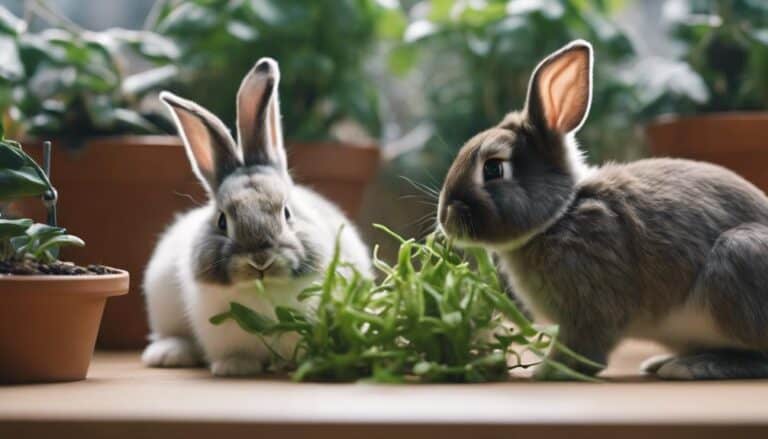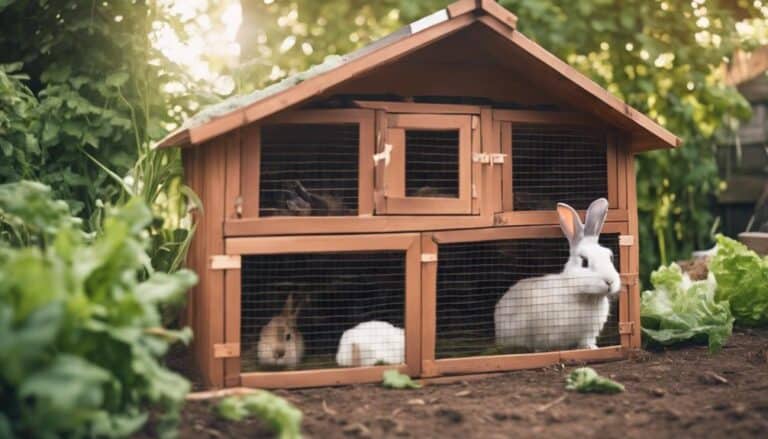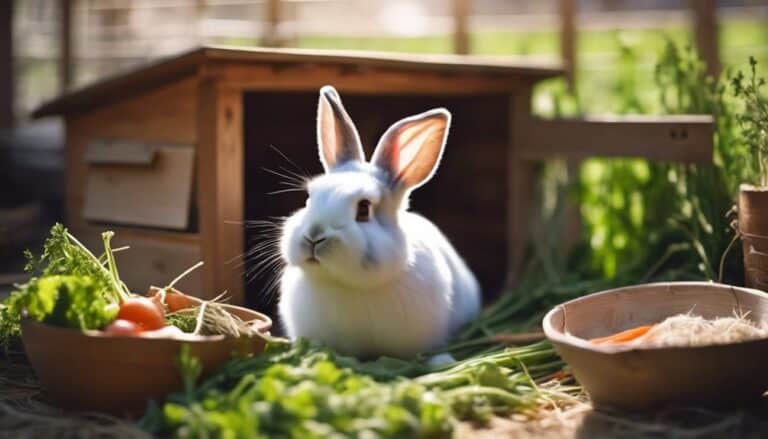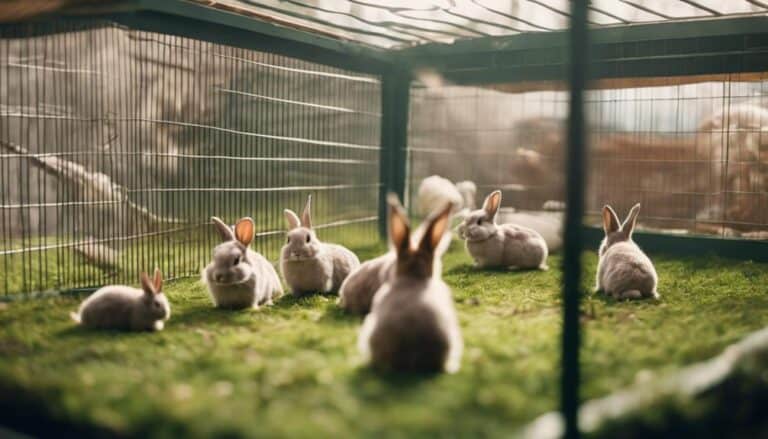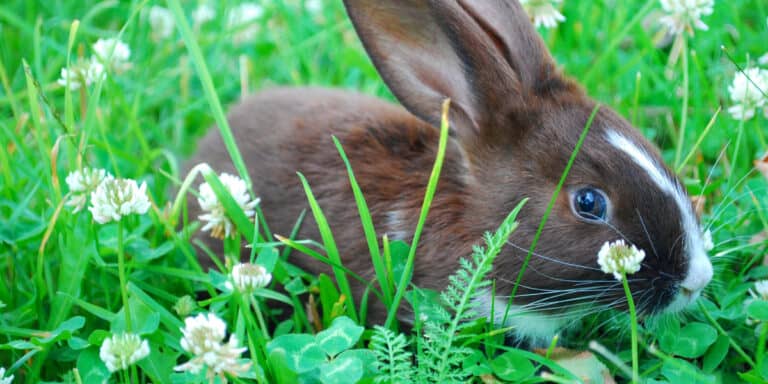Have you ever wondered if there's a way to greatly increase the survival rate of bunny litters without compromising their well-being?
Implementing innovative techniques and advanced technology in your bunny breeding practices might hold the key to addressing this challenge.
By exploring the latest trends in bunny farming, you could uncover groundbreaking strategies that revolutionize how we manage bunny litters in 2024.
Stay tuned to discover the cutting-edge methods that could shape the future of bunny breeding practices.
Contents
Key Takeaways
- Select high-quality breeding stock and provide optimal care for large, healthy litters.
- Tailor nutrition plans based on age and breed, gradually transitioning to adult diet.
- Maintain clean, spacious housing with proper ventilation and lighting for bunny families.
- Monitor behavior, health indicators, and implement suitable health protocols for optimal litter management.
Bunny Breeding Best Practices
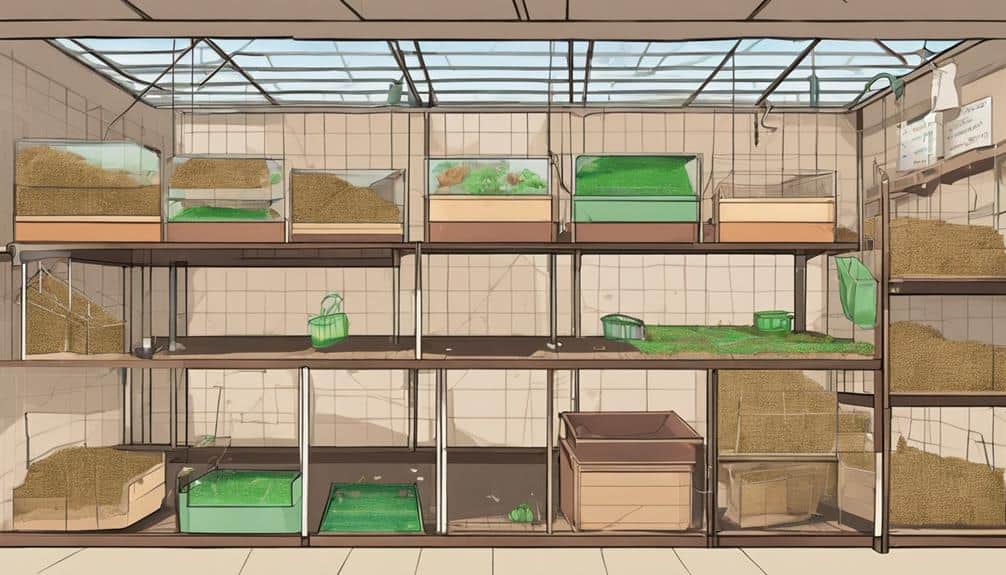
When breeding bunnies, guarantee success by selecting high-quality breeding stock with a proven track record of producing large, healthy litters. Ensuring proper rabbit care is essential for raising rabbits with excellent health and reproductive capabilities. Provide a well-balanced diet rich in nutrients to support the overall well-being of the breeding rabbits. Regular veterinary check-ups, vaccinations, and deworming are critical to maintain their health and prevent any potential illnesses that could affect the breeding process.
Create a comfortable and stress-free environment for the rabbits to encourage successful breeding. Pay close attention to the behavior and physical condition of the rabbits to detect any signs of distress or health issues early on. Maintain a clean living space for the rabbits to prevent the spread of diseases and maintain their overall health.
Health Monitoring for Bunny Litters
To guarantee the well-being of your bunny litters, consistently monitor them for any signs of illness, injury, or distress as part of their health monitoring routine. Keep a keen eye on their weight gain, activity levels, eating habits, and any unusual behaviors that may signal an underlying issue. Conduct regular health checks to assess their overall well-being and consult with a veterinarian to establish proper health monitoring protocols.
Here are five essential tips for effective health monitoring of bunny litters:
- Observe their behavior in the nest box and around the buck cage to catch any signs of distress early on.
- Regularly check for any injuries, such as scratches or wounds, that may require attention.
- Monitor their growth and weight gain to ensure they're developing at a healthy rate.
- Watch for changes in their eating habits or water intake, as these could indicate potential health problems.
- **Stay up to date on vaccination schedules recommended by the veterinarian to safeguard the bunny litters from common diseases.
Nutrition Guidelines for Bunny Offspring

Ensuring high-quality growth and health for bunny offspring involves implementing suitable nutrition guidelines tailored to their age and breed, overseen by a knowledgeable veterinarian. Bunny kits should begin nibbling on hay and greens around 3 weeks old to shift to an adult diet gradually. Provide them with alfalfa hay to support rapid growth until about 7 months old.
Introduce commercial rabbit pellets slowly starting at 7 weeks old. Avoid overfeeding high-calorie treats to prevent obesity and digestive issues. Consulting a rabbit-savvy veterinarian for specific nutrition guidelines based on the bunny offspring's age and breed is critical.
Nest boxes are essential for keeping the rabbits safe and comfortable during their early stages of growth. By following these guidelines and providing a balanced diet, you can guarantee the best start for your bunny offspring, setting them up for a healthy and thriving future.
Housing Solutions for Growing Bunny Families
As your bunny offspring continue to grow, providing suitable housing solutions for their expanding families becomes paramount to their well-being and development. Ensuring the comfort and safety of your bunny families is essential for their overall health and happiness.
Here are some essential strategies to contemplate when managing housing for your growing bunny families:
- Utilize spacious and well-ventilated metal cages: Provide ample space for your bunnies to move around comfortably and guarantee proper airflow to prevent overcrowding and related health issues.
- Incorporate nest boxes: Offer secluded spaces for does and their litters to promote a sense of security and protection within the living environment.
- Establish a regular cleaning schedule: Maintain cleanliness to prevent diseases and maintain a hygienic living space for your bunny families.
- Ensure proper lighting, heating, and cooling systems: Create a stable and comfortable environment for your bunnies to thrive and grow healthily.
- Monitor herd health closely: Keep a vigilant eye on your bunny families' well-being, promptly addressing any signs of illness or distress to safeguard their health and development, especially for those intended for meat production.
Behavioral Management for Bunny Younglings

When managing the behavioral aspects of young bunny litters, providing a nurturing and stress-free environment is essential for the well-being and development of both the mother rabbit and her babies. Implement nesting materials in the doe's cage to encourage her to build a comfortable nest for the younglings. This enables the mother rabbit to create a safe space for her babies to grow and thrive.
To further support a stress-free environment, minimize noise and disturbances around the nesting area. Ensuring a quiet atmosphere helps the mother rabbit feel secure and better care for her younglings. It's important to monitor the doe's behavior closely for any signs of neglect or aggression towards the babies. Intervene promptly if any concerning behaviors arise to protect the young rabbits.
Adequate space in the nesting area is critical to prevent overcrowding, which can lead to potential harm. Facilitate bonding between the mother rabbit and her younglings by allowing uninterrupted time together for feeding and grooming, fostering a strong maternal instinct and healthy development in the baby rabbits.
Frequently Asked Questions
How Do You Manage Rabbit Litter?
When managing rabbit litters, guarantee comfort and cleanliness. Provide a quiet area with appropriate bedding. Monitor kits regularly for health. Record their progress diligently. Remove soiled bedding promptly. Prioritize their well-being and development for a successful litter.
What Is the Best Way to Litter Train a Rabbit?
When training your bunny to use a litter box, remember to place it strategically, clean it often, and reward good behavior. Consistency and patience are crucial. Treats and praise go a long way in reinforcing positive habits.
What Is the Easiest Breed of Rabbit to Litter Train?
When choosing a rabbit breed for litter training, consider Mini Lop or Holland Lop for their ease of training. Consistent positive reinforcement and patience are key. Provide a suitable litter box and use proper training techniques for effective results.
How Often Do You Change a Rabbit's Litter Box?
You should change your rabbit's litter box daily to keep it clean and reduce health risks. By scooping out soiled litter regularly and using absorbent material, you can help maintain hygiene and minimize odors.
Conclusion
As you navigate the world of bunny litters in 2024, remember to be the guiding light for your furry companions. Just as a skilled gardener tends to delicate blooms, nurture your bunny litters with care and expertise.
By following the best practices outlined in this article, you can cultivate a flourishing rabbitry that blossoms with health and happiness. Embrace the role of the bunny whisperer and watch your bunny family thrive like a vibrant garden in full bloom.


